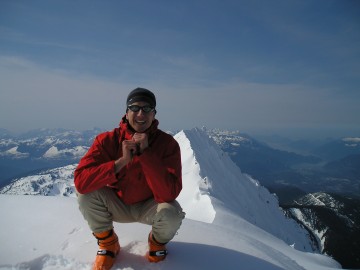Hypothermia victims whose hearts have stopped functioning should be transported to a medical facility with advanced heart and lung support equipment, even if that means longer travel time, according to a new study by a UBC medical resident.
In a study published today in the New England Journal of Medicine, Doug Brown and collaborators from Banff, Austria and Italy reviewed the medical literature and concluded that two aspects of the European approach to hypothermia rescue – rewarming and transport –should be adapted and applied worldwide.
“Appropriately equipped hospitals are more dispersed here in North America than in Europe, so transport times are longer,” Dr. Brown says. “But our review shows that hypothermic patients can tolerate many hours of cardio-pulmonary resuscitation (CPR) and still have a good neurologic outcome.
“Transporting a patient to a hospital with advanced heart and lung support increases the odds of surviving hypothermia-induced cardiac arrest so much, that it’s worth the trip.”
Cardiopulmonary bypass (CPB) and extracorporeal membrane oxygenation (ECMO) removes carbon dioxide from, and adds oxygen to, a patient’s blood, while supporting their blood pressure until the heart is warm enough to pump again. Dr. Brown’s review found that hypothermia victims in cardiac arrest have a 50 per cent chance of surviving if CPB or ECMO is used, compared to a survival rate of 0 to 37 per cent when not used.
Extended exposure to cold can overwhelm a person’s ability to generate heat, and lead to a drop in their core temperature. This leads to shivering and confusion, ultimately causing failure of the heart, lungs and other major organs.
For patients who are very cold but with good heart function, the study concludes that traditional invasive re-warming techniques – such as injecting warm water into the chest and abdomen – are not worth the risks of bleeding and infection. Rather, those patients should be warmed using non-invasive methods such as hot air blankets, placement in a warm room, monitoring and supportive care.
Dr. Brown, an avid mountaineer, has been involved with mountain rescue in British Columbia for 15 years. He earned his MD from UBC in 2004, and is in his final year of post-graduate training in emergency medicine.
“This excellent work by Dr. Brown and his collaborators will inform ongoing updates to the British Columbia Ambulance Service Treatment Guidelines, and will further stimulate discussion on the expanded use of advanced heart and lung support equipment by our critical care transport service,” said Dr. John M. Tallon, Vice President, Medical Programs for the British Columbia Emergency and Health Services Commission. “These insights would be particularly helpful in optimizing patient outcomes in B.C., with our challenging geography and distances to critical care centres.”
The British Columbia Ambulance Service (BCAS) Treatment Guidelines are being developed by the British Columbia Emergency and Health Services Commission to replace pre-hospital care protocols for paramedic employees. The commission says the guidelines “are not a linear step-by-step approach, but rather provide options within the appropriate scope of practice to allow paramedics to address the patient’s specific needs.”
Dr. Brown’s collaborators on the article were: Hermann Brugger of the Institute of Mountain Emergency Medicine at the European Academy of Bolzano in Italy; Jeff Boyd of Mineral Springs Hospital in Banff; and Peter Paal of Innsbruck Medical University in Austria.

